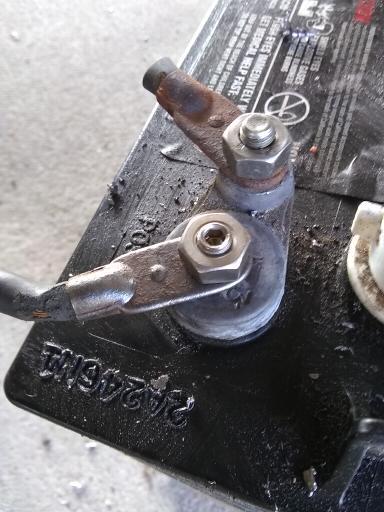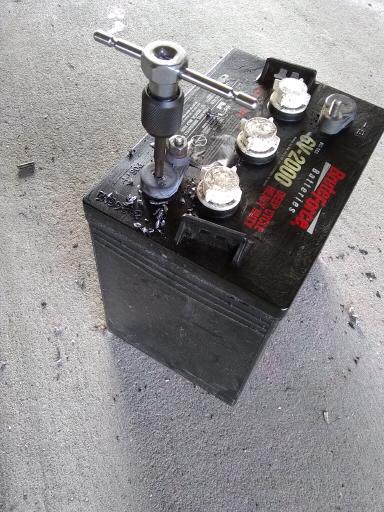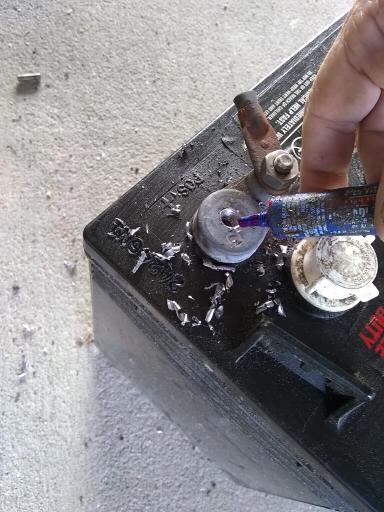Battery cables and their connections to the battery terminals can go bad. A common scenario is one in which the cart starts to jerk when trying to take off, or stops altogether, or even just smells hot. So, you lift up the seat and you see the end of one of the battery cables looks “cooked”. Several things could have caused this to happen. Probably the most common thing is that the connector on the battery wasn’t tightened properly. You’ve got to remember that when you tighten the nut that holds the battery cable end (I’ll refer to this as the connector) to the battery (I’ll call this the terminal), you are counting on the nut pressing the connector tightly down onto something that is made out of lead. Lead is kind of a “spongy” material and needs some special consideration when it comes to connecting electrically to it. It tends to “flatten out” any high or rough spots in the terminal, after the pressure of the nut is applied. So, what seems like a good solid connection when the nut is first applied, can become a loose connection after the pressure of the nut has had time to press high or even just rough spots into the lead. After tightening the nuts down, the connection should be given some time (like a day or so) to settle things out and then the nuts should be retightened. You can go ahead and drive the cart, but after about 24 hours or so, lift the seat and retighten the nuts on the batteries again. How tight should the nuts be tightened down? Most battery manufacturers recommend that the nuts be tightened to about 110 inch-lbs. That comes out to about 9 ft.-lbs. Most people are not going to use a torque wrench every time they tighten the battery nuts down, but if you have a torque wrench, it is a good idea to use it on the nuts at least one time (set to 9 ft-lbs.) and just get the “feel” for how tight that is.
Another common reason that a connection to the terminal will go bad is due to the build-up of corrosion in the connection/terminal area. Unfortunately, corrosion is a “way of life” in dealing with lead acid batteries. The batteries need to be washed off periodically to minimize its effects. What can also happen with corrosion, is that it takes place back up under the rubber jacket of the battery cable to where you can’t see it. It eventually destroys strand after strand until the remaining wire isn’t sufficient to carry the current needed to operate the cart. This introduces resistance to the current flow, and wherever there is RESISTANCE there is HEAT.
No matter what caused it, when you have an issue with one of the connection/terminals or cable problems, the area where the problem is, generally gets so hot that it damages the lead connector, and usually “welds” the nut to the terminal. It can also melt the lead down to where the terminal is no longer usable in its present form. When you try to get the nut off of the terminal, it will either break off or just spin in the lead. BUMMER. So, there you are, with a cable end stuck on the terminal, but you can’t tighten it or get it off.
Fortunately, there is usually a “fix” for the whole mess. Instead of replacing the cable and the battery, the terminal can generally be “repaired”.
When you look at the battery terminal assembly, it consists of a round pad where its connection to the internal plate of the battery is, and then there is a “tab” that comes out of the pad that provides a place for the terminal (bolt) to stick up. The terminal is actually a bolt that is sticking up, with its head molded into the lead below. And that’s the problem. Once the bolt “spins” in the lead from trying to turn it with the nut welded to it, it’s all over for that part of the terminal. However, what you can do is to go into the pad next to the terminal and “create” a new one.
The first thing we need to do is to get the old battery connector out of the circuit. I simply cut it off of the end of the battery cable and once the rest of the repair has been made, replace it with a new one. There is no need to remove the old one from the battery. Just let it hang there. It won’t hurt a thing, once it is disconnected from the battery cable. If you don’t have a crimping tool to install the new connector, it might be easier to just disconnect the cable at its other end and replace the whole cable. Then we’ll drill a new hole in the pad and tap it to fit a new “bolt” in the form of a 5/16 by 18 thread per inch stainless- steel socket set screw. It’s quite important that you use a stainless-steel socket set screw. You can do the job with another type, but it will quickly corrode. I’ve seen every kind of a screw that you can imagine being used to just screw the new connector to the pad without tapping the pad, but they just don’t work good AT ALL (in my opinion). They usually loosen up after a while and create further problems. With the method we are using, the new one will be just as good as the original and last the life of the battery. I’ve been using this technique to replace terminals for well over 12 years, and I’ve never had one go bad unless there was some unusual circumstance (like someone didn’t tighten the nut down correctly on the new terminal).
So, once the old connector has been cut off of the terminal, it’s time to drill the pad so that it will accept the new terminal. This step is very important. The hole we drill needs to be just the right size and that ends up being a letter “F” lettered drill. It is 0.257 inch in diameter and is just right for the 5/16 inch stainless-steel socket set screw that we will use as our new terminal. I’ve tried using a slightly smaller and a slightly larger bit (just because they were more readily available), but it doesn’t work worth a darn. The terminal just doesn’t fit the hole correctly. Drilling in lead is kind of tricky because the bit tends to “stick” in the soft lead. I find it best to just drill a small distance, back the bit out, clean the lead from the flutes of the bit, and go again. It may take four or five passes to complete the job. Drill the new hole about ¾ of an inch deep.
Then the next step is to tap the hole you just drilled with a 5/16 inch diameter by 18 thread per inch tap. Tapping in lead is just as tricky as drilling in it and requires some patience also. Only twist the tap a couple of turns (or less) at a time. After each time, stop and clean lead out of the flutes of the tap, and then go a little bit farther and repeat the process, until you have reached the bottom of the hole. You will know when you’ve reached the bottom, as it will become impossible to tap any further, without breaking something. The drill leaves a rounded bottom to the hole, so the tap won’t go “completely” to the bottom of the hole, but once you screw the new terminal in as far as it will go, it will leave plenty of the new terminal sticking out above the hole to accommodate the new connector and its new nut. The following are pictures of what the process looks like:


The next thing to do is to put about 3 drops of a thread locking agent into the bottom of the hole. I use the “Red” or “Blue” version of the “Loctite” product, but any good thread locking product will work just fine.

The next step is to use a hex (Allen) wrench to screw the socket set screw into the hole. Then it’s just a matter of replacing the connector on the end of the cable (or replacing the whole cable) and you are done. In many cases, it is possible to do the whole process without removing the battery from the cart, but in some cases, you just don’t have enough room to work, so you have to take the battery out.
Doing the repair in this fashion, gives you a new terminal that is screwed into the pad in a very secure way, and through the years, I have only had one, odd ball battery that wouldn’t let me tighten the socket set screw down. It would strip out. It was as if the lead was somewhat “chalky”. I guess that it had to do with the type or condition of the lead that was used in the manufacture of the battery. However, that was one out of dozens that I have done, and the rest have all been successful. Remember, that you must be able to find a stainless-steel, one inch long socket set screw and an “F” lettered drill bit to do the job. We have a local Ace Hardware store that carries lettered bits, so, at least where I live, that part is easy. Our local Home Depot carries stainless-steel socket set screws (most of the time) so, that is easy also. If you can’t find the stainless-steel socket screw, there are may places on the internet that have them available. Good Luck, Ron.
Ron Staley has published the following books, and you can get more information about them by just clicking on each title below:
Electric Golf Cart Repair 101 (and a half)
Techniques, Tips, Tools and Tales
Gas Golf Cart Repair 101 (and a half)
Techniques, Tips, Tools and Tales
4-Stroke Golf Cart Engines Explored
What Makes Them Tick
By an old Slot Machine Mechanic